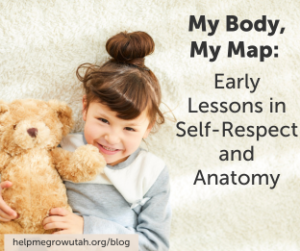 Do you remember the first time your little one discovered their hand? The wonder in their eyes as their tiny fingers curled and stretched as if they had unlocked a secret? Or maybe you can recall that adorable moment they brought their hand to their mouth, exploring its shape, taste, and texture, like a whole new world? Your child is naturally curious about themselves, eager to understand every little part of their body, and the way it all functions. As parents, we have the beautiful opportunity to not only teach our child about their bodies but also influence how they feel about their bodies!
Do you remember the first time your little one discovered their hand? The wonder in their eyes as their tiny fingers curled and stretched as if they had unlocked a secret? Or maybe you can recall that adorable moment they brought their hand to their mouth, exploring its shape, taste, and texture, like a whole new world? Your child is naturally curious about themselves, eager to understand every little part of their body, and the way it all functions. As parents, we have the beautiful opportunity to not only teach our child about their bodies but also influence how they feel about their bodies!
As parents, our openness to and attitudes toward the subjects of our bodies and sexuality strongly correlate with how our child will feel and think about these important topics. Communication about these topics should be ongoing and natural, just as we talk with our children about family plans for the weekend. A study done at the American Academy of Pediatrics found that children who discussed bodies and sexuality with their caregivers more often tended to perceive a closer bond with them. Additionally, they experience a healthier bond with themselves.
So how do we achieve this? Here is a general guide to age-appropriate discussion, working from younger to older age concepts that we can implement:
Understanding and Terminology: From the very beginning of a child’s life, we can instill the value of respect for our body and other’s bodies. Use the correct terminology to describe body parts to your child. Children have a right to adequate vocabulary, especially of the sexual organs, which will lead them to be more comfortable talking about sex healthily in the future (Goldman, 2014). If you notice your child trying to understand their body, including touching themselves, remember that their intentions are pure, and be cautious about how you respond. Teach about appropriate touching of the self and others, free of underlying tones of judgment or messages of shame.
Establish a Comfortable and Open Atmosphere: We have the opportunity to engage curiosity rather than fear with our children. How would you respond if your little one asked you a question you weren’t quite expecting yet, such as, “Why do boys and girls have different parts?” Rather than shaming them for their natural curiosity, which is a wonderful thing, try saying, “That is a great question! I am glad you are curious about bodies!” Questions should always be encouraged and responses should be tailored to the child’s age and maturity (Padilla-Walker et al., 2024). Trust your gut when it comes to the extent of information your child needs– you know them best. As you consistently demonstrate openness, you will be seen as a trustworthy and reliable source.
Basic Mechanics: Many parents don’t see their six to ten-year-olds as developmentally ready to learn about the basic mechanics of sex, but an age-appropriate conversation is very beneficial (Flores & Barroso, 2017). This initial discussion can offer them a healthy attitude about sexuality before other influences enter in and bombard them with confusing messages. Emphasize the importance of emotional and relational aspects of intimacy, along with addressing basic physical aspects. Keep the environment relaxed, encouraging dialogue as opposed to a monologue, and you will become a dependable source.
*Bonus tip: talk only about healthy sexuality here, and do not mix in body safety. These topics need to be addressed on separate occasions, otherwise it can promote conflicting feelings.
Maintaining Regular Communication: Ongoing communication leads to better outcomes for both children and parents. As you continue to have conversations with your child, adapting to their growth, these discussions will feel more natural and comfortable for both parties and will strengthen your bond (Martino, 2008). The more frequent your conversations, the more confidence you will gain in your role as a sexuality educator, equipped with the skills you need to effectively help your child (Teo & Morawska, 2021).
To my fellow caregiver: you’ve got this! You won’t do this perfectly, and that’s completely okay. With consistent efforts, you will see the wonderful impact you have on your child. Keep trying, genuinely supporting your little one to the best of your ability, and they will appreciate your efforts in the long run. Work on implementing these tips, one at a time. I promise you will see the difference.





